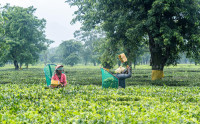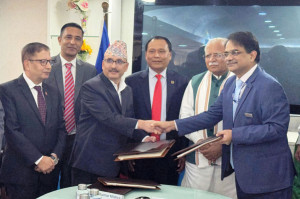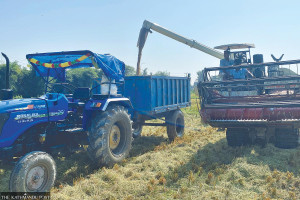Money
Bumper paddy harvest likely due to fast pace of transplantation
Paddy transplantation across the country has progressed faster this year raising the prospect of a bumper harvest which will boost farm incomes, rev up overall economic growth and help Nepal regain the status of a food surplus country.
Paddy transplantation across the country has progressed faster this year raising the prospect of a bumper harvest which will boost farm incomes, rev up overall economic growth and help Nepal regain the status of a food surplus country.
Thanks to an above-average monsoon this year, transplantation across the country as of August 7 stood at 94.36 percent of 1.42 million hectares compared to 75 percent in the same period last year.
The transplantation rate is similar to 2011 when the country witnessed a bumper paddy harvest of 5.07 million tonnes.
“If normal rains continue in September—the peak germinating and flowering period for paddy—the country could record a bumper harvest this year,” said Kamal Prasad Acharya, an agri economist at the Ministry of Agricultural Development. “Due to good rains, we expect a rise in the paddy acreage too.”
He said that transplantation was likely to be completed in a few weeks. “This year, the government ensured that farmers had sufficient chemical fertilizer.”
Due to the Tarai unrest when winter crops were growing in the fields last year, the government failed to distribute a large amount of chemical fertilizer. “The current stock could fulfil the requirement for winter crops too.”
The Food and Agriculture Organization of the United Nations (FAO), in its latest assessment of Nepal’s agriculture sector, has forecast that the 2016 summer paddy output will recover to 4.8 million tonnes, up 13 percent from the reduced 2015 level.
The FAO said that rains had been above-average over most of the country since mid-May which has benefitted paddy transplanting activities.
Last year, Nepal’s overall cereal crop output dropped 7 percent to 8.61 million tonnes, resulting in a sluggish economic growth of 0.77 percent. Paddy output fell sharply by 10.22 percent to 4.29 million tonnes.
The FAO said that excessive precipitation triggered localized flooding and landslides in parts of the Central and Western regions, but the impact on early planted crops is expected to be minimal.
This year, the monsoon entered Nepal on June 15 and covered the entire country by June 20.
The ministry’s statistics show that paddy transplantation has been completed on 95.84 percent of the 58,438 hectares of fields in the mountain region.
Transplantation in the hills and Tarai has been completed on 96.22 percent of 382,569 hectares and 93.55 percent of 984,339 hectares respectively.
The Tarai, which is the largest paddy producing region in the country, accounts for 71 percent of the total rice acreage. The hills account for 25 percent and the mountain region 4 percent. In terms of geographical distribution, the Far Western, Mid-Western and Western regions saw the highest transplantation rate. According to the ministry, transplantation in the Far Western Region has been completed on 99.88 percent of the 170,117 hectares of paddy fields.
Transplantation in the Mid-Western and Western regions has been recorded at 98.72 percent of 172,648 hectares and 98.90 percent of 308,090 hectares.
Similarly, transplantation in the Central and Eastern regions has been completed on 92.72 percent of 391,624 hectares and 87.95 percent of 382,867 hectares. Last year, 9 percent of the country’s total rice fields were left unplanted due to a poor monsoon.
Nepal has slid back into a food deficit this fiscal year largely due to a sharp drop in cereal production. According to the ministry’s statistics, the country has a food deficit of 71,387 tonnes.





 21.12°C Kathmandu
21.12°C Kathmandu














